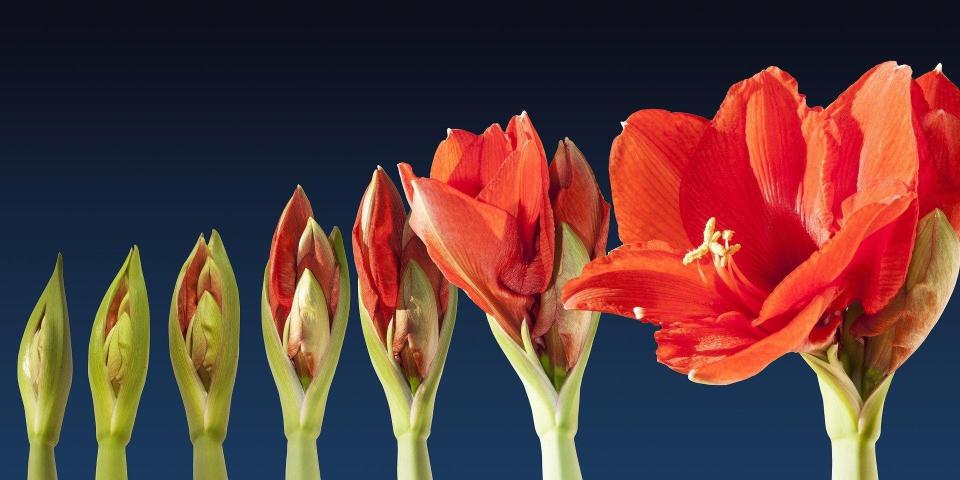Master Gardener: A Holiday Favorite - Amaryllis

Perhaps an amaryllis plant was given to you over the holiday, the blooms are spent, and you are thinking, "Now what — should I keep it or toss?" Hopefully this article will help you decide.
Where and what to purchase:
Amaryllis may be purchased as bare or planted bulbs. The bulbs are available for purchase from a reputable catalog company, a box store, or a local greenhouse. Select the largest bulbs available for the variety you want — the larger the bulb the more flowers it will have. Bulbs should be firm and dry with no signs of mold, decay, or injury. Choose bulbs with bright new green growth. Check the height of the mature plant. Remember you get what you pay for. It pays to spend $$ if planning on enjoying your amaryllis plant year after year.
When to plant:
It takes six to eight weeks for the blooms to appear, so, for Christmas blooms, plant in mid-October. A waxed amaryllis blooms in four to six weeks. The bloom time depends on variety — different weeks given from different sources. It also depends on the temperature where the plant is located.

Three Planting Methods
● Planting in a pot. Select a container that is 1 to 2 inches wider than the bulb. Make sure the pot has drainage holes. Use a nutritional potting mix. Place potting mix in bottom of pot, firmly press down, center bulb, add additional mix leaving half of the bulb above the soil. Leave one inch between top of soil and pot’s rim. The bulb needs to set above the container. Water until the potting soil is thoroughly moist.
● Waxed bulbs require no planting or watering. Can decorate them up with faux snow or wrap in moss. A coiled wire embedded at the base makes them freestanding or set them in a clear glass vase or nestle them in holiday decorations.
● Planting in water. Select a vase slightly larger than the bulb. Use decorative stones or glass pebbles and water. Begin by adding the decorative stones filling vase two-thirds to three-fourths full. Aquarium charcoal can be added to prevent odor. Trim off dead or brown roots. Keep the white, fleshy roots. Gently work the roots and a fraction of the base of the bulb into the stones. Add water, making sure only the roots and base of bulb are touching water. If bulb sits in water, it will rot.
Care:
Once potted, place plant in a warm location (70 to 75 degrees). Allow top two inches of potting mix to dry before watering again. Apply water soluble fertilizer (10-2-15) N (nitrogen), P (phosphorous), K (potassium) every two to four weeks. As plant grows, turn pot daily to keep the stalk growing straight. If needed, stake the plant stalk so it remains upright.
When it begins to bloom, move to a cooler location (65 to 70 degrees) with no direct sun. This prolongs the bloom time.
Waxed bulbs need no watering … the waxed bulbs hold all the stored energy and water it needs to bloom. Waxed bulbs are once and done. They are only good for the season so after blooming, discard. However, I recently read in a Gardener’s Supply Catalog that wax can be removed from bulb and potted. They offer an instructional video at gardeners.com/rebloom.
Amaryllis roots grown in water need to have the water changed to prevent unhealthy root growth, slimy roots, and odor. Rinse off decorative stones and replace bulb with roots submerged. Bulbs grown in water do not normally do as well as the potted bulbs.
OK, it has bloomed – now what
After the flowers have faded, cut them off to prevent seed formation. Do not remove flower stalks until they have turned yellow. Place the potted plant in a bright sunny location indoors to grow long, smooth leaves. (Pot the amaryllis grown in water.) The object is to promote photosynthesis — so the plant stores nutrients and creates energy for repeat blooming. Continue to water and fertilize regularly.
After danger of frost has passed, move plant outdoors placing first in the shade or indirect light. Gradually move to an area that receives 6 hours of sun daily. Bring indoors before first frost. Amaryllis do not require a dormant period. They will bloom again if allowed to continue to grow.
If you want to control the bloom time it can be done by forcing the bulb to go dormant. To do this, store the potted bulb in a cool, dark, dry location such as basement or closet. Let the leaves become brown before cutting off. Do not water. Inspect for mold or mildew. If that appears, treat with a fungicide or toss. After 8 to 12 weeks place pot in a sunny location. I have also taken the bulb out of the pot, let dry, and placed it in the refrigerator in a brown paper bag to cause dormancy. After allotted time, remove and pot. You can also do this with bulbs purchased or received too early for potting. The potted bulb only needs to be repotted after 3 or 4 years. Repot after dormancy.
As for me, amaryllis are a joy. So, I encourage others to purchase a large bulb of the variety they like, pot it up, and enjoy its blooms for years to come.
This material was taken from University of Minnesota Extension, Iowa State University Extension, Nikki Tilly, Author of the Bulb-o-licious Garden, and Garden Supply Company.
Carolyn Johnson is a Master Gardener with the Sandusky and Ottawa Counties Extension Officers.
This article originally appeared on Fremont News-Messenger: Master Gardener: A Holiday Favorite - Amaryllis

